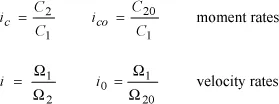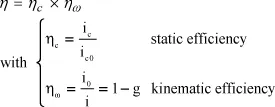![]()
Chapter 1
Overview of Mechanical Transmission Problems 1
1.1. Technological aspects
The direct approach of a system of mechanical transmission of power may be delicate. In this chapter, we propose to assimilate a real mechanism to a discrete mechanical system. We will then identify its main components and propose a classification based on their efficiency (in section 1.1.1; see also [SPI 97]). The general theorems of mechanical application to these simple models after an easy mathematical treatment will highlight the relevant parameters governing machine performance and point to directions of thought in order to improve the command of those mechanisms (sections 1.1.2, 1.1.3 and 1.1.4; see also [SPI 97]). Finally, the main elements of tribology will be presented in section 1.1.5. Indeed, the study of friction and lubrication and their consequences constitutes an essential part in the conception and the functioning of machines.
1.1.1. General structures of the machines
These engines are connected with machines through transmission power systems or mechanisms such as gearings, belts or chains, clutches or brakes, systems connecting rod-crank or the sawnut systems, cams or eccentric, elastic coupling.
Any mechanism is put in motion by an entrance element called the leading or driving element, which supplies the driving energy. An exit element called the led or receiving element is the element by which the energy connected to loads goes out of the mechanism. The power circulates from the engine towards loads. The exit of a component constitutes the entrance of the next component.
1.1.1.1. Engine
In a power converter, the engine receives as an input an electrical power; as an output this power is always a mechanical power (couple and angular speed or strength and linear speed). The variation curve of the couple or the strength according to the speed is the curve of capacity of the engine, the characteristic of the engine. This conversion involves losses and therefore the notion of the engine’s efficiency is introduced.
1.1.1.2. Loads
Loads are the linear efforts and torques applied to the parts of the machine situated downstream of the studied part. Loads represent the resistances induced by the environment of the machine and result from their functioning. They are the loads of friction, gravity and slowness.
1.1.1.3. Energy efficiency
The classification of the numerous existing mechanisms can rely on the energy efficiency expression. By definition, the efficiency is the ratio of supplied energy to the necessary energy to supply.
The mechanism of Figure 1.1 receives the power P1 and supplies the mechanical power P2 to the receiver 2. The mechanism 1 being real, there is a Pp power being lost and transformed into heat in 1. The efficiency on the mechanism 1 is written:
The nature of the movement being assumed to be unchanged in 1 (here a rotation), we can write:
C1, C2 are the torques applied to 1, 2 respectively.
Ω1, Ω2, are the angular speeds of driveshaft 1, 2 respectively.
In the case of a perfect mechanism, there are no losses and then P1 = P2 = P20, with P20 = C20 Ω20.
By making reference to a perfect mechanism, the efficiency of a real mechanism can be written as:
By dividing every term by C1 Ω1 and putting
the real mechanism can then be written as:
where ηc expresses losses by friction and ηω characterizes the internal gliding in the mechanism.
We can then write
This approach allows the classification of mechanisms into two big categories:
– Positive mechanisms: the transmission of efforts is done by contact without sliding and the gliding factor remains 0. This concerns the gearings, the chains, the eccentric and the sawnut systems for which ηω =...








